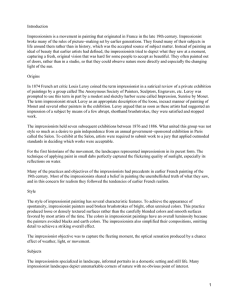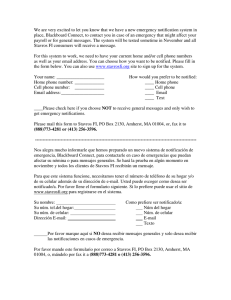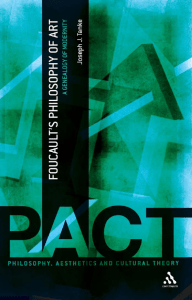Music and plastic arts
Anuncio
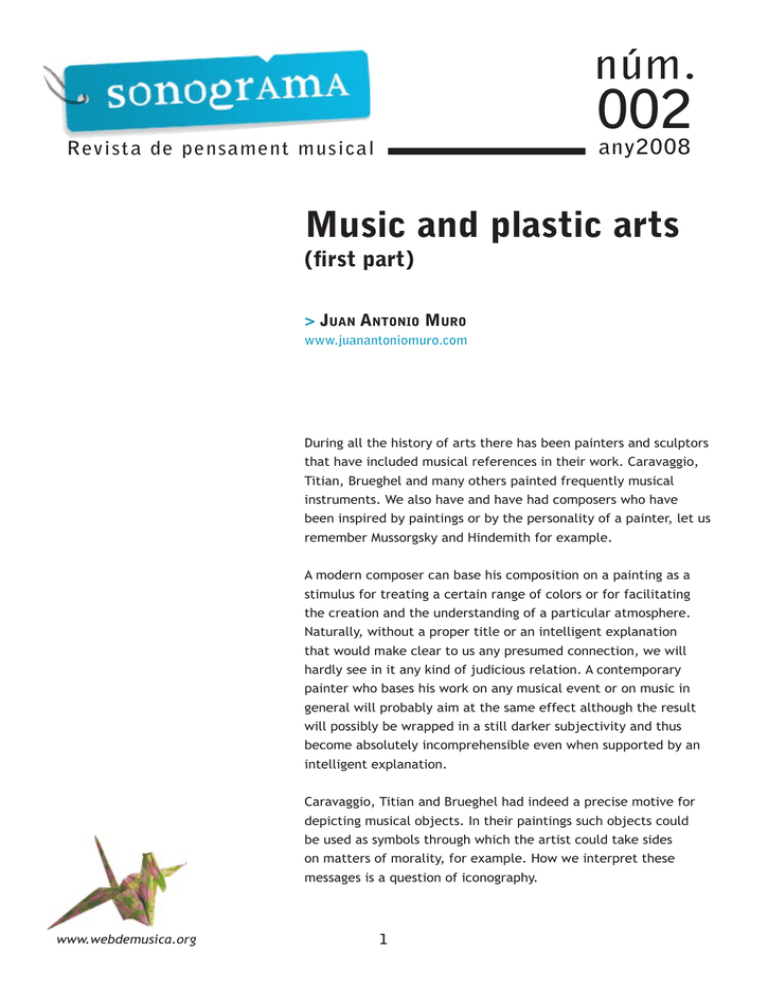
núm. 002 any2008 Revist a de pensament m usical Music and plastic arts (first part) > Juan Antonio Muro www.juanantoniomuro.com During all the history of arts there has been painters and sculptors that have included musical references in their work. Caravaggio, Titian, Brueghel and many others painted frequently musical instruments. We also have and have had composers who have been inspired by paintings or by the personality of a painter, let us remember Mussorgsky and Hindemith for example. A modern composer can base his composition on a painting as a stimulus for treating a certain range of colors or for facilitating the creation and the understanding of a particular atmosphere. Naturally, without a proper title or an intelligent explanation that would make clear to us any presumed connection, we will hardly see in it any kind of judicious relation. A contemporary painter who bases his work on any musical event or on music in general will probably aim at the same effect although the result will possibly be wrapped in a still darker subjectivity and thus become absolutely incomprehensible even when supported by an intelligent explanation. Caravaggio, Titian and Brueghel had indeed a precise motive for depicting musical objects. In their paintings such objects could be used as symbols through which the artist could take sides on matters of morality, for example. How we interpret these messages is a question of iconography. www.webdemusica.org 1 núm. Sonograma 002 R ev i s t a d e p e n s a m e n t m u s i c a l any2008 However iconography is not going to be my subject. I will speak about the aesthetic and constructive connections and mutual influences of both arts through our near history. I focus on what plastic arts - specially painting - has in common with music if we take in consideration some basic components of both arts, such as formal structure, time, space, rhythm, etc. Synesthesies and synergies Everyone is familiar with such expressions as ”musical poetry” or ”poetical architecture”, to mention only two examples. We speak about musical color and we say that a certain painting brings up musical elements to our mind. It is also common to relate form in music with form in architecture. Our culture has created these sorts of aesthetic ideas in order to facilitate the understanding of certain significances and lead us into more complete artistic experiences. For example ”colorful music”, a subjective image that belongs to a certain world of perceptions affects another image that belongs to a totally different world of perceptions. We call that synesthesia, something affecting subjectively some other thing. In spite of some relevant studies existing about Synesthetics, it is my opinion that these kinds of sensations, as well as those related with synergism - everything affecting everything in a whole - do not need to be proved, perhaps not even understood in order to be fully experienced. When we speak about the relation between music and plastic arts we have the tendency of limiting our mental activity to these ways of experience. We automatically think about the emotional, physiological, psychological etc. effects of colors and we think how to relate them to the same effects of the music, or viceversa. There are privileged ears that relate sounds to colors. Unfortunately those are very personal experiences. They are impossible to be proved and still more difficult to share with other people. www.webdemusica.org 2 núm. Sonograma 002 R ev i s t a d e p e n s a m e n t m u s i c a l any2008 There is an other phenomenon which belongs to the extremely interesting but rather imprecise world of synesthesias. And that is the act of ”painting music”, that is to say painting under the influence of the music that we are listening to. A common activity where a stimulus of a certain perceptual nature is pretended to be expressed through a medium belonging to a different modality. There is a great synergic power when two different art forms are put together in the right way and in an appropriate space. And a successful ’listening-painting’-situation can produce a ’something-in-between’ experience, the experience of a a ’third space’ . An interesting subject when we speak about creativity or about art therapy. Parallelism, not transformation But, as I said before, my aim here is to treat the subject from an objective angle. And that being so I realize first of all that I do not dispose of a valid procedure to relate a sound or a tonality to a concrete color, the sound C to red color for example. I also realize that if ’The Old Castle’ of ’Pictures of an Exhibition’ by Modest Mussorgsky actually sounds like an old castle is because I know the name of the piece and its source of inspiration. That happens, of course, because arts can not be translated in the manner we can translate languages. In the relation between two arts there is parallelism, but not objective transformation. There are indeed similarities and connections between music and painting that we can concretize and empirically examine. For that we can analyze the ways artists of both art modalities use their common elements; that is in this particular case, for example, formal structure, time, space, etc. Music uses sound. A composer organizes sounds and relates them to each other as to form a controlled totality, with which he manipulates time. As far as time is concerned music affects the listener, we could say, in a magical way. Music is able to neutralize time, make time disappear. Color and form are the materials of plastic arts and the artist controls them as to manipulate space. Both tridimensional and bidimensional arts, sculpture or painting, affect the idea of space www.webdemusica.org 3 núm. Sonograma 002 R ev i s t a d e p e n s a m e n t m u s i c a l any2008 in the spectator. They can expand or reduce the idea of space around us. Time is a problematic element for plastic arts. Traditional plastic arts can not control ’chronological’ time. But, on the other hand the spectator can get a complete idea of a whole painting in a single moment. He can also look at the painting as long as he wants, observe little details as he likes and when he wants. He can regulate his activity, because the visual happening gives freedom. In a concert the listener cannot do the same. Music moves at its own immutable rhythm. The listener cannot do anything to avoid this process. He is a slave of the auditive happening, because auditive happening is unconditional and subordinating. Space Painters and composers do not move in a physically tridimensional space like architects or sculptors. Their space is two-dimensional. The painter controls a flat and limited space, a canvas. The composer controls time, also limited, that moves not in a deep direction, but linearly, we could say that music moves like text, from left to right. Painters and composers use perspective rules if they want to create in the viewer or in the listener a sense of profundity, a sense of deepness. The mathematical perspective was found in the 14th century and it was considered for many centuries the only possible way of showing perspective. But in the 19th century came the impressionists and they demonstrated that perspective can also be represented with colors For example, we experiment a cold color, let’s say blue, being further away than a warm color, let’s say yellow. If we look at this painting of Mark Rothko (Painting 1A, upside down) as it is shown in the first picture, we get a strong idea of a landscape. And that is because we identify blue as the sky and yellow as a field and, of course, the separation line of both colors as the horizon. When the cold color is over the horizontal line and the warm color is below it, we can speak about color perspective. www.webdemusica.org 4 núm. Sonograma 002 R ev i s t a d e p e n s a m e n t m u s i c a l any2008 Painting 1B - Mark Rothko Yellow and Blue on Orange”, 1972 Oil on canvas 102x66’’ Carnegie Instittute, Pittsburg Painting 1A - Mark Rothko Yellow and Blue on Orange”, 1972 Oil on canvas 102x66’’ Carnegie Instittute, Pittsburg shown upside down: blue up, yellow below But this painting shouldn’t be looked in this way. This painting should be looked in this other way: Painting 1B In this painting we can hardly speak about color perspective. It is evident that the painter is not painting a landscape. Cold color, blue, is brought in by putting it below the horizon. Warm color, yellow, is pushed out by being over the horizon line. If the painter wants to make both colors equal in activity, if he wants to equilibrate his painting, this is a way to do it . www.webdemusica.org 5 núm. Sonograma 002 R ev i s t a d e p e n s a m e n t m u s i c a l any2008 He can underline the perspective. Or he can contradict the rules of the perspective and avoid it. There is an other interesting detail here: the darkest surface is smaller than the lighter one. This is a way of equilibrating ’the weight’ of the painting. If both parts would have an equal surface the lower part of the painting, the darkest part, would be too heavy. Baroque painters learned how to create an impression of profundity in their paintings and they found also the way of representing light. They placed their colors in layers, one over the other, lots of them, combining complement colors, transparent colors of different clarity. We know how baroque composers created light and space. Bach for example. But only after Debussy got interested in light and space we start speaking about colors, instrumental and harmony colors, as structural elements in music. Both painting and music can be elaborated by layers that can underline profundity or light. They can contain a great number of them that can be seen or heard as a whole or separately. Composers create space : A- by means of an appropriate instrumentation, for ex.trumpet con sordino against cello. B- with the right dynamics and instrumental color, for ex. piano sul ponticello against mezzoforte sul tasto. C- using more or less intensity, vibrato or non vibrato, etc. There are, naturally, in contemporary music other more sophisticated ways of creating space. www.webdemusica.org 6 núm. Sonograma 002 R ev i s t a d e p e n s a m e n t m u s i c a l any2008 Time As I said before traditional plastic art can not control chronological time. But, using a proper composition and a proper language the painter too is able to manipulate time producing in the viewer a need for a long observation. If a painter wants to use the idea of time he will face two problems. A painting must have an instant effect on the viewer as to attract him but, at the same time it must keep him attached to it, for as long as possible. Painting 2 - Vasily Kandinsky, Improvisation George ,1914, 110 x110 Städtische Galerie, Munich A painter can place his elements on the canvas in such an order as to cause in the viewer the need of ”reading” the work as slowly as possible. If all the elements are different from each other and there are many of them the reading happens still slower. Vasily Kandinsky, painting 2. A painting that has not an instant effect will difficultly call our attention. With, of course, some exceptions. And on the other hand the painting that has nothing but an instant effect can easily bore us. There are different ways of treating the problem. www.webdemusica.org 7 núm. Sonograma 002 R ev i s t a d e p e n s a m e n t m u s i c a l any2008 There are techniques with which an artist seems to create spaces for silence and meditation. We need more than an instant to realize their contents and, when we observe them, even the cold colors seem to become warm. The sense of time disappears. Mark Rothko, painting 3. Jackson Pollock was contemporary of Rothko. However his technique is completely different. He uses time in a very dynamic way. He obliges us to move our eyes in a Painting 3 - Mark Rothko ”Blue and Grey”, 1972 Oil on canvas, 79’’x69” Frederick Weisman Family Collection fast tempo from one margin to the other, in all directions also in profundity. Jackson Pollock, painting 4. Painting 4 - Jackson Pollock ”Lavender Mist”, 1950 National Gallery of Art, Washington www.webdemusica.org 8 núm. Sonograma 002 R ev i s t a d e p e n s a m e n t m u s i c a l any2008 Rhythm, Harmony, Chord We know that rhythm is the breathing and the pulse of the music. But rhythm means a lot also for a plastic artist. Painting 6 - Mark Rothko ”Gren and Red on Orange”, 1972 Oil on canvas 102”x66’’ Carnegie Instittute, Pittsburg Painting 5 - Vasily Kandinsky The White Dot A painter too builds up the form of his work using the rules of rhythm.The way he places his elements on the canvas, forms and colors, creates the rhythm of the work. Vasily Kandinsky, painting 5. When a painter speaks about color combination he uses the word ”harmony” or ”chord”. A consonant chord if the colors complement each other. Like in this painting of Mark Rothko (Painting 6) where green works as the complement color of red. www.webdemusica.org 9 núm. Sonograma 002 R ev i s t a d e p e n s a m e n t m u s i c a l any2008 Painting 7- Carolus Enckell ”Hashi”, 1986-89, 200 x 280 and 35 x 27 Helsinki City Art Museum In the color-disc yellow and green are as near to each other as for example C and D in a music scale. The interval between yellow and green is small, and together they create tension, we could even say that they create a dissonance. In this painting of the Finnish painter Carolus Enckell (Painting 7), neither of the colors is supported by its complement color, green and yellow are fighting for controlling the space and would need something to quiet them. Green would need red and yellow would need violet. The combination of both colors create a dissonant chord, they create tension which can resolve on a consonance or not. Just like dissonance in music. Only when we look at the small painting beside do we calm down. Two warm red-grey squares contain both complement colors we need: violet for the yellow and red for the green - partly because of the strong influence of the large green-yellow surface beside it -. Their lack of luminosity and intensity as well as the reduced space where they are make them peaceful; they become ”consonant”, they are not fighting for power. This is how a dissonance can resolve into a consonance, or if we want, a dominant chord into a tonic chord. www.webdemusica.org 10 núm. Sonograma 002 R ev i s t a d e p e n s a m e n t m u s i c a l any2008 Counterpoint Painting 8 - Sam Vanni ”Contrapunctus”, 1960, 150x450 Helsingin Työväenopisto, Helsinki The idea of counterpoint is used by painters in its etymological sense, that is: ”point against point” , ”object against object”, and that means conflict, contradiction, antithesis... whatever opposition. The subject of this painting (painting 8) is, according to its author, the ”materia in chaos” that is represented in the left side of the triptych. The middle part represents the humans struggle in order to control that chaos. Here we can see clearly the idea of ”point against point”, ”element against element” and their struggle. In the right part we see order and harmony that has been achieved through the struggle. The basic contrast is between the left and the right side, chaos and order. The elements of the painting experiment a gradual change towards the final balance. www.webdemusica.org 11 núm. Sonograma 002 R ev i s t a d e p e n s a m e n t m u s i c a l any2008 Form We are speaking about similarities. Elements that music and traditional plastic arts have in common. We shall use the same painting for speaking about form. In music a very classical form is ABA, the form of the sonata. What happens in a sonata? In section A-1 - exposition - composer presents the material of his composition, the themes, in a way as to accumulate tension for example trough modulations. If we relate A-1 of the sonata form to Sam Vanni’s left side of the painting we see that the painter’s presentation of his subject too makes us feel its tensed energy, that of the ”materia in chaos”. In section B of the sonata - development - , the material presented in A-1 experiments changes through a more or less dramatic struggle, development of the themes, modulations, restless movement, etc. Also the central part of this tryptich goes through a dramatic struggle, ’human struggle in order to control the chaos’, says the painter himself. We can see much activity in it, agitation, confrontation, disorder, drama. In the third part of the sonata form, section A-2 - repetition -, the composer comes back to the material presented in the beginning, he repeats it. But something very decisive happens: There is no more the tension of the first part. The tension created in the first part is discharged, there are no remarkable modulations, the confrontation of the themes is no more dramatic, we are coming to peace and harmony. We are coming home. The right part of Vanni’s painting represents this harmony and order. Peace has been achieved through fight. Drama is an important element in western art. Western art is based on conflict, on confrontation and struggle. Western art is based on drama. We want art to reflect our lives, both man’s inner conflicts and states of harmony. Art reflects both disintegration and integration. An interesting work of art is the one that goes through a tempest, manages to get out of it and prepares itself to meet the next obstacle. -------------- www.webdemusica.org 12 núm. Sonograma 002 R ev i s t a d e p e n s a m e n t m u s i c a l any2008 In the second part we shall comment mutual influences of both arts through our near history, analyzing their points of contact, for example Impressionism and Kandinsky’s abstraction against Schönberg’s dodecaphonism. We shall use paintings from Monet, Cézanne and Kandinsky among others. -------------- Juan Antonio Muro, 20098 The pictorical work of Juan Antonio Muro can be seen in the website www.juanantoniomuro.com and is musical work through the Finnish Music Information Center www.fimic.fi www.webdemusica.org 13
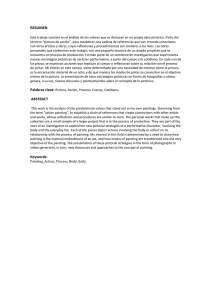
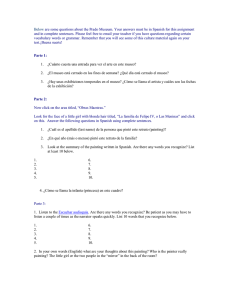

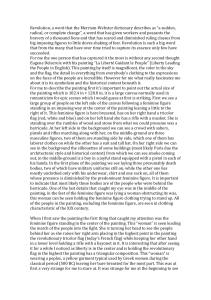
![Ramón Gaya. Homenaje a la pintura [Homage to painting]](http://s2.studylib.es/store/data/005849811_1-91ba15d434a4105913f2f22ee385b0f2-300x300.png)
